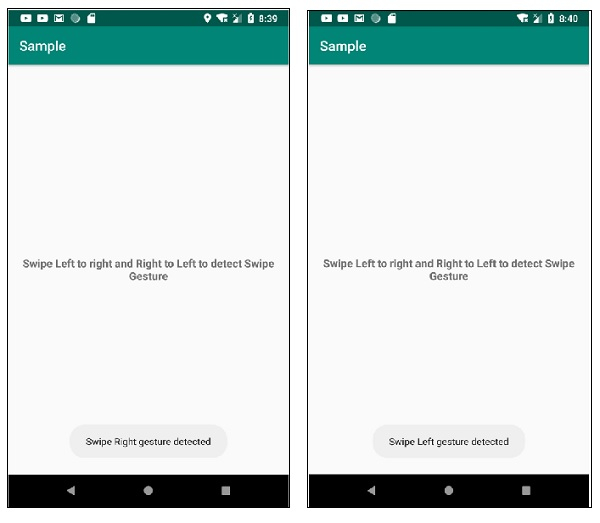
 Data Structure
Data Structure Networking
Networking RDBMS
RDBMS Operating System
Operating System Java
Java MS Excel
MS Excel iOS
iOS HTML
HTML CSS
CSS Android
Android Python
Python C Programming
C Programming C++
C++ C#
C# MongoDB
MongoDB MySQL
MySQL Javascript
Javascript PHP
PHP
- Selected Reading
- UPSC IAS Exams Notes
- Developer's Best Practices
- Questions and Answers
- Effective Resume Writing
- HR Interview Questions
- Computer Glossary
- Who is Who
How to handle right-to-left and left-to-right swipe gestures on Android?
This example demonstrates how do I handle right to left and left to right swipe gestures on android.
Step 1 − Create a new project in Android Studio, go to File ⇒ New Project and fill all required details to create a new project.
Step 2 − Add the following code to res/layout/activity_main.xml.
<?xml version="1.0" encoding="utf-8"?> <RelativeLayout xmlns:android="http://schemas.android.com/apk/res/android" xmlns:tools="http://schemas.android.com/tools" android:layout_width="match_parent" android:layout_height="match_parent" android:padding="4dp" android:id="@+id/relativeLayout" tools:context=".MainActivity"> <TextView android:layout_width="wrap_content" android:layout_height="wrap_content" android:textAlignment="center" android:layout_centerInParent="true" android:textSize="16sp" android:textStyle="bold" android:text="Swipe Left to right and Right to Left to detect Swipe Gesture"/> </RelativeLayout>
Step 3 − Add the following code to src/MainActivity.java
import androidx.appcompat.app.AppCompatActivity;
import android.os.Bundle;
import android.widget.RelativeLayout;
import android.widget.Toast;
public class MainActivity extends AppCompatActivity {
RelativeLayout layout;
@Override
protected void onCreate(Bundle savedInstanceState) {
super.onCreate(savedInstanceState);
setContentView(R.layout.activity_main);
layout = findViewById(R.id.relativeLayout);
layout.setOnTouchListener(new OnSwipeTouchListener(MainActivity.this) {
@Override
public void onSwipeLeft() {
super.onSwipeLeft();
Toast.makeText(MainActivity.this, "Swipe Left gesture detected", Toast.LENGTH_SHORT).show();
}
@Override
public void onSwipeRight() {
super.onSwipeRight();
Toast.makeText(MainActivity.this, "Swipe Right gesture detected", Toast.LENGTH_SHORT).show();
}
});
}
}
Step 4 − Create a java class (OnSwipeTouchListener.java) and add the following code −
import android.content.Context;
import android.view.GestureDetector;
import android.view.MotionEvent;
import android.view.View;
class OnSwipeTouchListener implements View.OnTouchListener {
private GestureDetector gestureDetector;
OnSwipeTouchListener(Context c) {
gestureDetector = new GestureDetector(c, new GestureListener());
}
public boolean onTouch(final View view, final MotionEvent motionEvent) {
return gestureDetector.onTouchEvent(motionEvent);
}
private final class GestureListener extends
GestureDetector.SimpleOnGestureListener {
private static final int SWIPE_THRESHOLD = 100;
private static final int SWIPE_VELOCITY_THRESHOLD = 100;
@Override
public boolean onDown(MotionEvent e) {
return true;
}
@Override
public boolean onSingleTapUp(MotionEvent e) {
onClick();
return super.onSingleTapUp(e);
}
@Override
public boolean onDoubleTap(MotionEvent e) {
onDoubleClick();
return super.onDoubleTap(e);
}
@Override
public void onLongPress(MotionEvent e) {
onLongClick();
super.onLongPress(e);
}
@Override
public boolean onFling(MotionEvent e1, MotionEvent e2, float velocityX, float velocityY) {
try {
float diffY = e2.getY() - e1.getY();
float diffX = e2.getX() - e1.getX();
if (Math.abs(diffX) > Math.abs(diffY)) {
if (Math.abs(diffX) > SWIPE_THRESHOLD && Math.abs(velocityX) > SWIPE_VELOCITY_THRESHOLD) {
if (diffX > 0) {
onSwipeRight();
} else {
onSwipeLeft();
}
}
}
else {
if (Math.abs(diffY) > SWIPE_THRESHOLD && Math.abs(velocityY) > SWIPE_VELOCITY_THRESHOLD) {
if (diffY > 0) {
onSwipeDown();
} else {
onSwipeUp();
}
}
}
}
catch (Exception exception) {
exception.printStackTrace();
}
return false;
}
}
public void onSwipeRight() {
}
public void onSwipeLeft() {
}
private void onSwipeUp() {
}
private void onSwipeDown() {
}
private void onClick() {
}
private void onDoubleClick() {
}
private void onLongClick() {
}
}
Step 5 − Add the following code to androidManifest.xml
<?xml version="1.0" encoding="utf-8"?> <manifest xmlns:android="http://schemas.android.com/apk/res/android" package="app.com.sample"> <application android:allowBackup="true" android:icon="@mipmap/ic_launcher" android:label="@string/app_name" android:roundIcon="@mipmap/ic_launcher_round" android:supportsRtl="true" android:theme="@style/AppTheme"> <activity android:name=".MainActivity"> <intent-filter> <action android:name="android.intent.action.MAIN" /> <category android:name="android.intent.category.LAUNCHER" /> </intent-filter> </activity> </application> </manifest>
Let's try to run your application. I assume you have connected your actual Android Mobile device with your computer. To run the app from the android studio, open one of your project's activity files and click Run ![]() icon from the toolbar. Select your mobile device as an option and then check your mobile device which will display your default screen −
icon from the toolbar. Select your mobile device as an option and then check your mobile device which will display your default screen −

Click here to download the project code.

